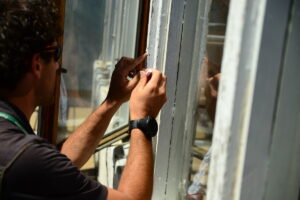In New York City, lead-based paint remains a major health concern, particularly in older buildings. Local Law 31, enacted as part of the city’s ongoing effort to protect residents, especially children, from the dangers of lead poisoning, requires landlords to conduct lead paint inspections regularly. Failure to comply can lead to legal issues, hefty fines, and even forced remediation.
It is important to know what triggers a Local Law 31 lead paint inspection, especially for property owners, landlords, property managers, and tenants alike.
In this blog post, we’ll break down the top 5 violations that most commonly lead to an inspection under Local Law 31 and how you can avoid them.
Top 5 Violations That Trigger a Local Law 31 Lead Paint Inspection
1. Presence of Peeling, Chipping, or Deteriorated Paint
This is the number one red flag for HPD inspectors. If peeling or damaged paint is reported or observed, particularly in a building constructed before 1960, it often triggers an immediate investigation.
Why it matters:
Deteriorated paint is the most common source of lead dust, which is highly toxic when inhaled or ingested. Children are especially vulnerable, as they may chew on windowsills or put dusty hands in their mouths.
Avoid it:
Conduct regular visual inspections and promptly repair any signs of damaged paint. Use safe work practices and ensure repairs are done by certified professionals if lead paint is suspected.
2. Failure to Conduct a Proper XRF Lead Paint Inspection
Many landlords delay or skip the legally mandated inspection, thinking they can avoid it if no problems are visible. However, Local Law 31 requires XRF inspections regardless of whether lead is suspected, provided the building meets the age and occupancy criteria.
Why it matters:
HPD has access to records and complaints. If a landlord hasn’t filed proof of inspection or can’t provide documentation during a routine audit or following a tenant complaint, it can trigger an official lead inspection.
Avoid it:
Hire an EPA-certified lead inspector to conduct an XRF test and keep proper records of the findings. Make sure to have documentation ready to show compliance.
3. A Child Under Age 6 Residing in the Unit Without a Lead-Free Certification
One of the most sensitive triggers is the presence of a young child in a home with unknown or untested lead conditions. Under Local Law 1 and reinforced by Local Law 31, if a child under 6 lives in the unit, the landlord must:
- Perform annual lead paint investigations.
- Remediate any lead hazards immediately.
- Complete a certified XRF inspection within one year.
Why it matters:
Lead poisoning can cause developmental delays and learning disabilities in children. The city takes this seriously. Even a tenant’s informal mention of having a child can initiate an inspection if proper documentation isn’t in place.
Avoid it:
Require tenants to complete an annual notice about child occupancy and take immediate action if a child under 6 is living in the unit. Schedule an inspection and follow through with remediation if necessary.
4. Unpermitted Renovation or Repair Work That Disturbs Paint
Renovation work that disturbs painted surfaces in pre-1978 buildings must follow specific EPA Renovation, Repair, and Painting (RRP) rules. Doing work without proper containment, cleaning, or notification can lead to a report and HPD investigation.
Why it matters:
Even minor work like sanding or drilling can release hazardous lead dust. Tenants or neighbors who observe unsafe work conditions often report them, triggering city intervention.
Avoid it:
Ensure all contractors are EPA RRP-certified and use proper lead-safe work practices. Always get permits for renovation projects and notify tenants as required.
5. Lack of Tenant Communication and Recordkeeping
One often-overlooked violation is simply failing to maintain proper records and tenant communication. Under Local Law 1 and 31, landlords must:
- Distribute annual lead notices to tenants.
- Keep records of tenant responses for 10 years.
- Record when inspections and remediations were conducted.
Why it matters:
If a complaint is filed and the landlord cannot produce evidence of compliance, the city may assume noncompliance. This can fast-track a lead paint inspection, even if the unit is actually safe.
Avoid it:
Use standardized forms for lead notices and keep meticulous digital and hardcopy records. Document every inspection, repair, tenant notice, and remediation step.
How to Prepare for a Local Law 31 Lead Paint Inspection
If you’re a property owner or manager, preparing proactively can save you time, money, and legal trouble. Here are a few steps to take:
- Identify Affected Units: Make a list of all units in pre-1960 (and 1960–1978 if applicable) buildings.
- Schedule XRF Inspections: Use certified professionals and do this before the August 2025 deadline or within one year of child occupancy.
- Repair Lead Hazards Promptly: Always use certified contractors for lead abatement or interim controls.
- Maintain Compliance Records: Keep lead inspection certificates, tenant notices, and repair logs in an organized, retrievable format.
- Educate Your Staff: Make sure maintenance and management teams are aware of safe work practices and reporting requirements.
Also Read: How Lead Dust Remediation Works: Step-by-Step Process
Hire Manhattan Lead for Reliable Lead Paint Inspection
Reach out to Manhattan Lead for reliable, certified lead paint inspections across NYC. Our expert team uses advanced XRF technology to ensure accurate, compliant results. We help property owners meet Local Law 31 requirements efficiently and safely. Contact us for thorough assessments and timely service. Schedule your inspection today!




